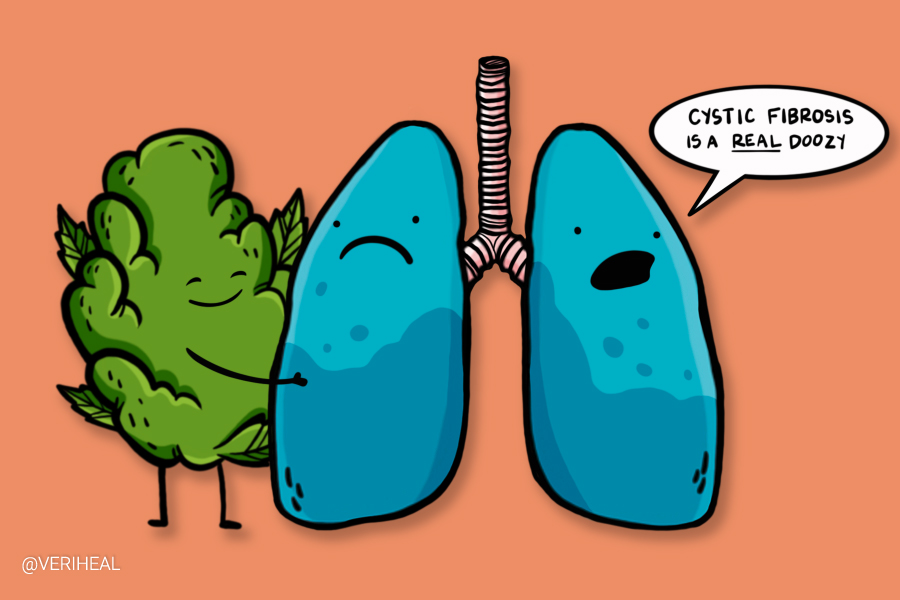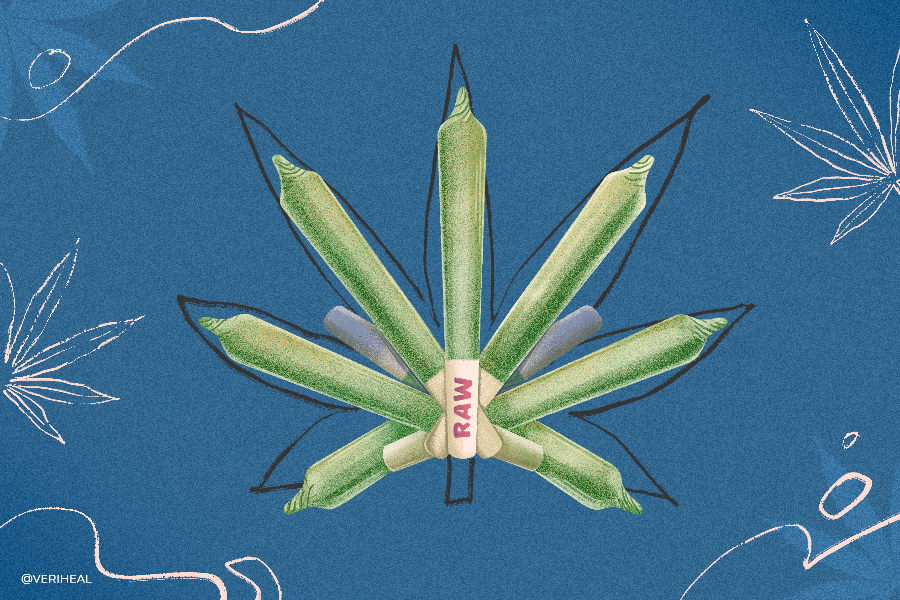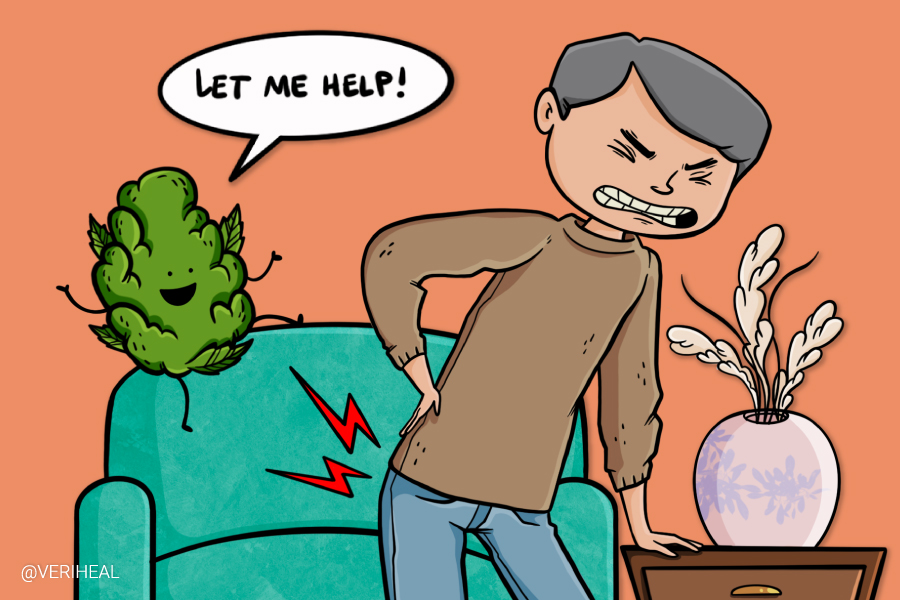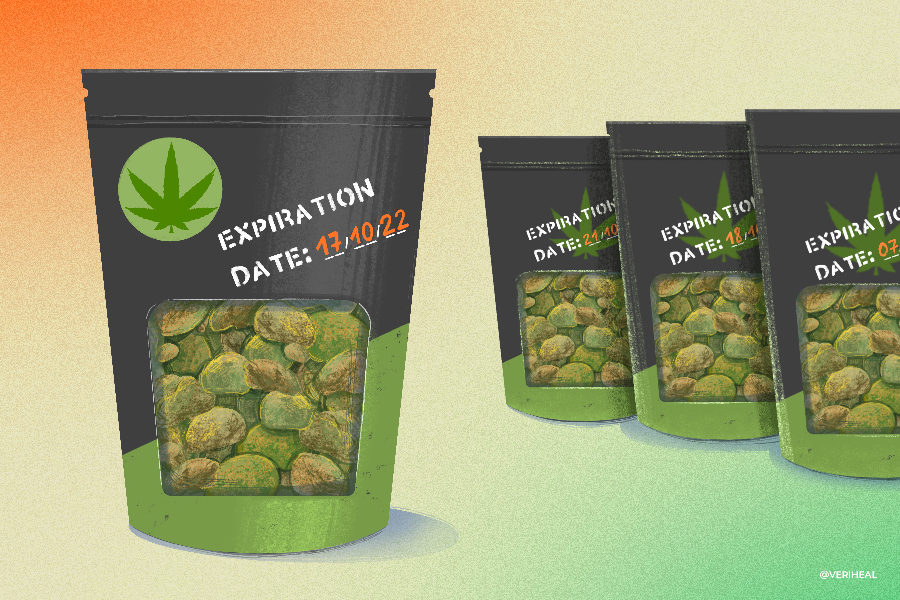Understanding Cannabis Treatment for Cystic Fibrosis

- Cystic Fibrosis: Signs, Symptoms and Types
- Cystic Fibrosis: Causes and Complications
- Cystic Fibrosis Treatment: Can Cannabinoids Provide Relief?
- The Role of the Endocannabinoid System in Treating Cystic Fibrosis
- What Preparations of Cannabis are Best for Cystic Fibrosis
- Talk to Your Doctor About Medical Cannabis
A progressive lung disease called cystic fibrosis causes distress for more than 40,000 children and adults across the U.S (1). This genetic condition affects the lungs, pancreas, and other vital organs, such as the intestines.
People of every ethnic and racial group risk developing cystic fibrosis. Data shows that around 105,000 people have received a doctor’s diagnosis for the medical condition across 94 countries.
Mutations occur in the cystic fibrosis transmembrane conductance regulator (CFTR) gene in cases of the disease, thus causing the CFTR protein to malfunction. Once the protein becomes incompetent, it cannot efficiently transfer chloride to the cell’s surface.
Chloride is a component of salt, which explains why many CF patients notice that their skin tastes abnormally salty, when there is insufficient chloride attracting water to the cell’s surface, a sticky and thick mucus forms in the body’s various organs.
Mucus buildup obstructs the airways and prevents germs from escaping. Because of this, CF patients face an increased risk of contracting infections or being diagnosed with inflammatory problems and respiratory failure, among many other health complications.
Mucus accumulation in the pancreas restricts the release of essential digestive enzymes that assist the body in absorbing food and vital nutrients. Consequently, people with CF tend to be malnourished and have stunted growth.
Cannabis is among the many treatment options that are available for patients. As a natural substance that could help CF patients with appetite, anxiety and depression, nausea and vomiting, bronchodilating, anti-inflammatory, anti-diarrheal, and pain-relieving effects. (4, 8)
Cystic Fibrosis: Signs, Symptoms and Types
Cystic fibrosis occurs in people with gene mutations or errors. Specifically, the mutations are found in the cystic fibrosis transmembrane conductance regulator (CFTR) gene. Once the CFTR gene malfunctions and stops producing CFTR protein or produces malformed CFTR protein that fails to carry out its vital function in the cell, you may experience a long list of chronic, progressive symptoms.
Most people with CF are diagnosed at birth through newborn screening or by age 2. A sweat test is the most common means of diagnosis (5). If any of the following symptoms surface in you or your child, make a trip to your local doctor’s office for a medical examination, testing, and diagnosis:
- Chronic sinus infections
- Coughing with phlegm
- Difficulty putting on weight
- Enlargement of the fingertips and toes
- Frequent lung infections, such as bronchitis and pneumonia
- Male infertility
- Nasal polyps
- Regular large and greasy stools or difficulty in making a bowel movement
- Rectal prolapse
- Salty-tasting skin
- Shortness of breath
- Wheezing
Five separate classes of CFTR mutations are outlined on the Cystic Fibrosis Association’s website: conduction, gating, protein production, protein processing, and protein deficiency (9). The most frequently reported type of CF mutation, F508del, is deemed to be a protein-processing mutation.
Cystic Fibrosis: Causes and Complications
As an inherited disorder, cystic fibrosis runs in families. Discussing your family’s medical history with a doctor or a genetics specialist is an excellent first step to discovering whether or not you face a high risk of having a child with CF. While CF can occur in various racial ethnicities, it is most common in Caucasians of northern European ancestry.
Thanks to technological advancements in newborn screening, cystic fibrosis can be diagnosed within the first month of a baby’s life. According to Healthline, CF affects approximately one in 2,500 to 3,500 white newborns. Symptoms need not develop for a diagnosis, but if the diagnosis is missed at birth, a diagnosis may be delayed until the signs of CF transpire later in life.
Based on information published on the Cystic Fibrosis Foundation’s website, it can only occur in children who inherit one copy of the genes from each parent (1). If a child inherits just one copy, it is highly unlikely they will develop cystic fibrosis. However, since they will be carriers of the defective gene, there’s a possibility that they will pass the disease on to their children.
Seeking reliable medical providers and specialists for cystic fibrosis is imperative for managing complications of the disease. Left untreated, CF will progress in many forms and be fatal at an earlier age. For example, the thick mucus can block the bile duct, resulting in liver disease. Male patients may also experience infertility.
Additionally, CF can cause digestive and respiratory problems, such as bronchial tube scarring, pneumothorax, coughing up blood (hemoptysis), and damaged airways (bronchiectasis). Other organs may also be affected by CF, and patients might also be susceptible to severe dysfunction and chronic infections.
Cystic Fibrosis Treatment: Can Cannabinoids Provide Relief?
According to the Cystic Fibrosis Foundation, over half of CF patients are aged 18 and older (3). Thanks to improvements in the medical sphere of cystic fibrosis, many people with the disease can lead healthy, happy lives into their 30s, 40s, 50s, and beyond. By adding cannabinoids to the mix, quality of life can be further ameliorated in CF patients, who might also benefit from various effects and mood improvement.
A research report published in 2002, titled “Cannabinoids and Cystic Fibrosis. A Novel Approach to Etiology and Therapy”, proposed the use of cannabinoids as a treatment for CF for the first time (4). In particular, the report focused on cannabis’ psychoactive compound delta-9 tetrahydrocannabinol (THC) and its appetite-stimulating properties, which could help alleviate malnutrition in patients.
The researchers also suggested that “…potential benefits from THC treatment, in addition to appetite stimulation, will include antiemetic, bronchodilating, anti-inflammatory, anti-diarrheal and hypo-algesic effects.”
A 2020 survey on CF patients using medical cannabis noted that those who self-reported use were mainly using it for pain and stress alleviation (8). They reported that “28 out of 31 found marijuana to be a great deal effective for their symptoms, and 21 of the 31 rated marijuana ” very important to their health.”
The non-psychotropic compound CBD (cannabidiol) could also help relieve cystic fibrosis symptoms since the cannabinoid may help to minimize tissue damage by exerting its anti-inflammatory, anti-anxiety, and antidepressant effects.
A study on the “Antioxidative and Anti-Inflammatory Properties of Cannabidiol” that was published in the journal Antioxidants (Basel) in 2020 found that CBD reduces the levels of pro-inflammatory cytokines, inhibits T cell proliferation, induces T cell apoptosis and reduces migration and adhesion of immune cells (2).
The Role of the Endocannabinoid System in Treating Cystic Fibrosis
Cystic fibrosis has a strong connection with many of our body’s integral systems, including the endocannabinoid system (ECS). The ECS produces cannabinoids and uses them to manage a whole host of functions that might influence the quality of life of people with CF, including appetite, nausea, inflammation, pain, and mood regulation.
The effects of the ECS can be experienced when a cannabinoid attaches to CB1 and CB2 receptors found within the system. These receptors can bind to the body’s endocannabinoids and the plant’s phytocannabinoids. The CB1 and CB2 receptors have been found in the immune cells and the gut, among virtually every organ system.
When cannabinoid receptors are activated, the surrounding tissue and nerves get a spa day. CB1 receptors have been identified in the vagus nerve, which transfers signals between the brain and the gut. Inflammation and other types of immune functions are impacted by cannabinoid receptor stimulation.
A study published in the Journal of Cannabis Therapeutics, titled “Cannabinoids and Cystic Fibrosis in February 2002”, found that CF patients display lower levels of endocannabinoids (4). They proposed that the CFTR may be involved in endocannabinoid synthesis as it is in fatty acid balance. Elevating these therapeutic compounds’ levels through medical marijuana use could promote symptomatic relief in cystic fibrosis patients.
This thought is also echoed in Dr. E.B Russo’s article on Clinical Endocannabinoid Deficiency (CED) regarding CF and many other disorders not yet fully managed by today’s medicine (7).
What Preparations of Cannabis are Best for Cystic Fibrosis?
You are not limited to smoking a joint or vaping (although these two methods of consumption offer fast relief) when you use medical cannabis for cystic fibrosis. The 2020 BMC survey on CF patients reported, “The most used forms were edible and vaporized (8).” However, harsh inhalational routes like smoking should be avoided. Any method or treatment should be discussed with your provider first.
However, myriad product options and preparations are available, each of which has benefits.
Listed below are some recommended choices for CF patients:
- Edibles — Chow down on a cannabis-infused edible for accurate dosing and effects that could last for 5-8 hours.
- Pills, capsules, and tablets — More discreet and convenient, this category of cannabis preparations for CF are ideal for controlled dosing while on the move.
- Powder Cannabis — Scientists have figured out how to make cannabinoids water-soluble, meaning that you can drink your medicine and experience improved bioavailability.
- Transdermal Patches — When you wear topical, transdermal patches, cannabis compounds get absorbed via the bloodstream after penetrating the skin.
- Tinctures — Another way cannabis can be used for CF is oil tinctures, which can be dropped beneath the tongue for rapid bloodstream absorption within minutes and better bioavailability than edibles.
Talk to Your Doctor About Medical Cannabis
To gain a broader understanding of the type of cystic fibrosis you are dealing with and to pinpoint any potential complications, your doctor or healthcare practitioner may conduct a series of tests and medical examinations. Once you’ve received a diagnosis, you can discuss medical cannabis use with a doctor.
Refrain from using cannabis as a substitute for other types of doctor-prescribed medications that relieve chronic pain, infections, and improve lung function in cases of CF. Instead, use it alongside conventional medicine (with a doctor’s approval). Be aware of potential side effects that might occur if you consume cannabis with other meds too.
Complementary Treatments Worth Discussing with Your Doctor
The diagnostic and therapeutic disciplines used alongside conventional medicine are known as complementary therapies. Examples of complementary medicine include massage, meditation, biofeedback, tai chi, reiki, music therapy, guided imagery and dietary supplements.
Remember that if you consult complementary practitioners (aside from osteopaths, naturopaths, and chiropractors), most can legally practice without licensing but with some previous training. They should have finished some further education or training course in their chosen discipline.
Integrating cannabis into your routine may also be a valuable decision. Connecticut is one state that permits the use of medical cannabis for cystic fibrosis, with CF being added to the list of qualifying conditions in 2016 (6).
You must continue using any medication(s) prescribed by your doctor and inform your doctor about your desire to medicate with cannabis.
Note: The content on this page is for informational purposes only and is not intended to be professional medical advice. Do not attempt to self-diagnose or prescribe treatment based on the information provided. Always consult a physician before deciding on the treatment of a medical condition.
1. About cystic fibrosis. Cystic Fibrosis Foundation. (n.d.). Retrieved September 26, 2022, from https://www.cff.org/intro-cf/about-cystic-fibrosis
2. Atalay, S., Jarocka-Karpowicz, I., & Skrzydlewska, E. (2019). Antioxidative and anti-inflammatory properties of Cannabidiol. Antioxidants, 9(1), 21. https://www.ncbi.nlm.nih.gov/pmc/articles/PMC7023045/#:~:text=Therefore%2C%20it%20has%20been%20suggested,of%20immune%20cells%20%5B66%5D
3. Betsy was diagnosed with CF when she was 1 ½ years old. Originally from San Antonio. (n.d.). People with CF are living longer. what does that mean for our care? Cystic Fibrosis Foundation. Retrieved September 26, 2022, from https://www.cff.org/community-posts/2022-08/people-cf-are-living-longer-what-does-mean-our-care
4. Fride, E. (2002). Cannabinoids and cystic fibrosis. Journal of Cannabis Therapeutics, 2(1), 59–71. https://www.researchgate.net/publication/233294071_Cannabinoids_and_Cystic_Fibrosis
5. Home. Cincinnati Childrens. (n.d.). Retrieved September 26, 2022, from https://www.cincinnatichildrens.org/health/c/cystic-fibrosis
6. Qualification requirements. CT.gov. (n.d.). Retrieved October 10, 2022, from https://portal.ct.gov/dcp/medical-marijuana-program/qualification-requirements
7. Russo, E. B. (2016). Clinical endocannabinoid deficiency reconsidered: Current research supports the theory in migraine, fibromyalgia, irritable bowel, and other treatment-resistant syndromes. Cannabis and Cannabinoid Research, 1(1), 154–165. https://www.liebertpub.com/doi/10.1089/can.2016.0009
8. Stephen, M. J., Chowdhury, J., Tejada, L. A., Zanni, R., & Hadjiliadis, D. (2020). Use of medical marijuana in cystic fibrosis patients. BMC Complementary Medicine and Therapies, 20(1). https://bmccomplementmedtherapies.biomedcentral.com/articles/10.1186/s12906-020-03116-x#citeas
9. Types of CFTR mutations. Cystic Fibrosis Foundation. (n.d.). Retrieved September 26, 2022, from https://www.cff.org/research-clinical-trials/types-cftr-mutations#:~:text=There%20are%20five%20classes%20of,be%20a%20protein%20processing%20mutation

















